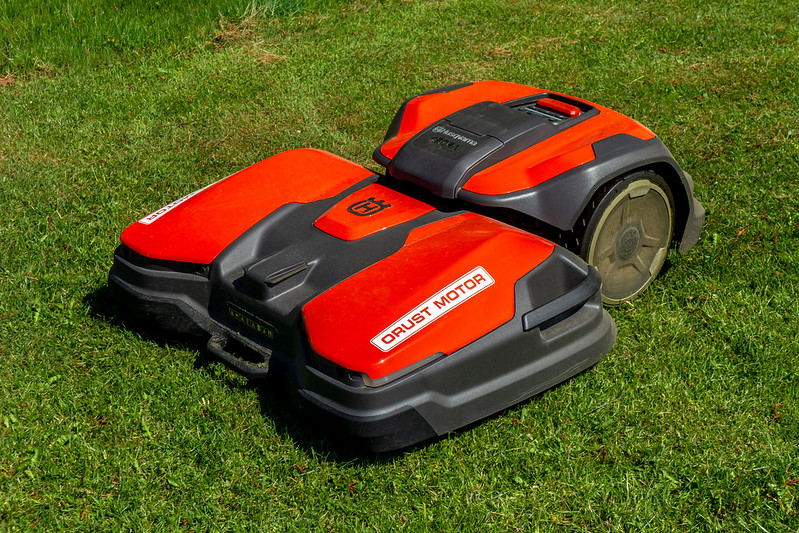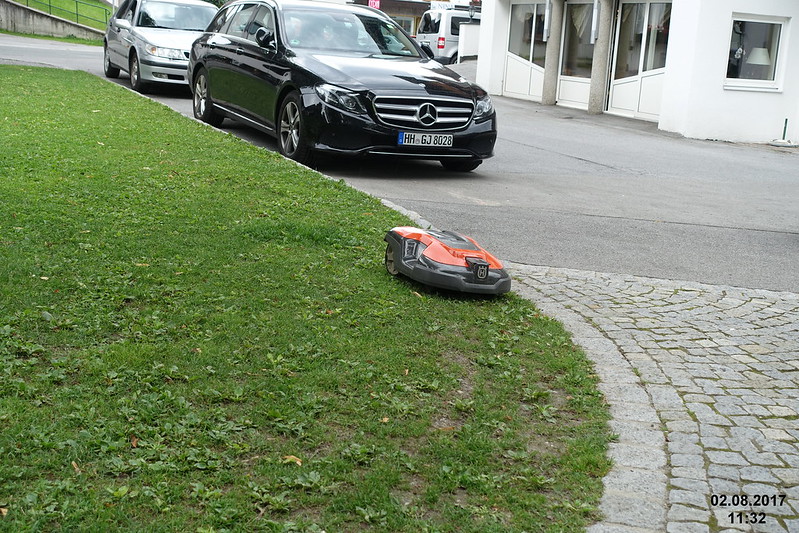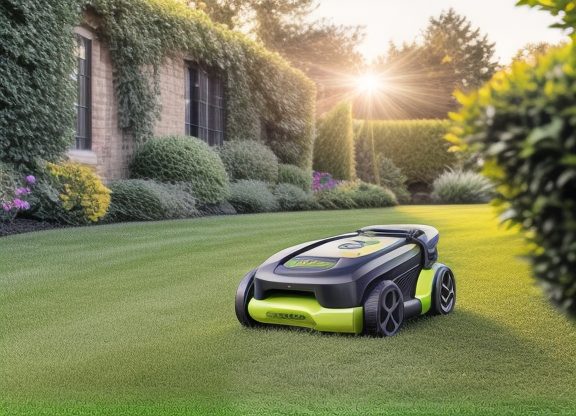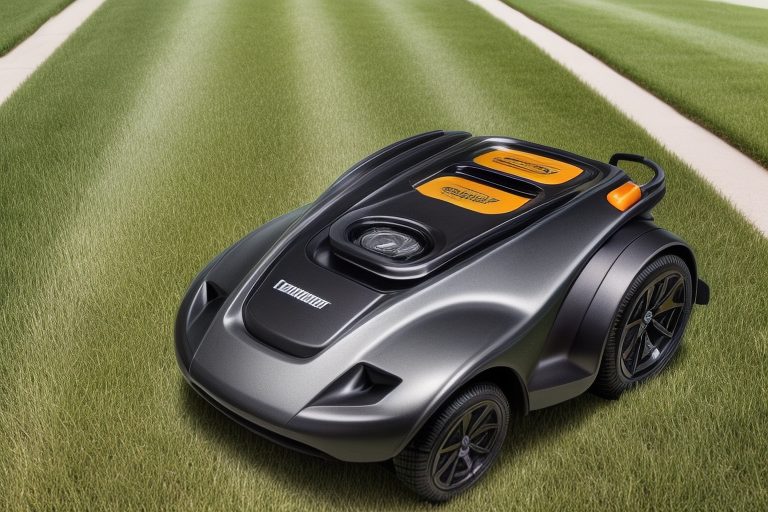==================
A Caveat and Affiliates
First off, a little caveat: within my articles you will find affiliate links, meaning if you buy them, I get a small commission. Your cost is not affected. In addition, I am an Amazon Associate and I earn from qualifying purchases on Amazon.
And yes, if I say that I recommend a product here, it means I truly believe it is a good product. I refuse to recommend any product that I have not researched and believe to be a good value.
Even better, I provide you with a very clear picture of the product, it’s use, and the probable value.
Earning your trust is important to me. I run this website myself and the commissions and donations help support the site.
Sound reasonable and fair enough? Let’s continue to the article.
==================
The rise of technology has changed the way we live and work. People from all walks of life are now embracing this change and how it affects their lives. The lawn care industry is not an exception.
Robot lawnmowers are causing a stir in the lawn care industry.

Husqvarna CEORA professional robotic lawn mower / Flickr / Ann-Sophie Qvarnström
You no longer need to sweat under the sun while mowing your lawn. These robotic mowers do all the grass-cutting for you and keep your lawn looking fresh.
However, like any other technology, robotic mowers can face issues from time to time. They are expensive pieces of gardening equipment. Understanding how to troubleshoot problems with robotic mowers is vital. It will help keep your lawn well-maintained and ensure your investment pays off.
In this post, we will run through common issues, solutions, and how you can prevent them. In addition, we will also explain tricky issues, like electrical testing and software glitches.
By the end, you will learn how to fix common issues with your robot lawn mower.
So, let’s begin!
Understanding Robot Lawn Mowers
Understanding the basics of your robot lawn mower is essential. It helps you troubleshoot problems efficiently and correctly.
A robot lawn mower is a gardening tool that automates the lawn mowing. It mows your lawn without having you ride or push heavy mowers under the scorching sun. All you need is to set up a perimeter wire around your yard to guide your mower where to mow.

A Robot Lawn Mower in Action / Flickr / Michael Coghlan
Moreover, you can program your mower to work at a particular schedule or let it roam freely. Robotic lawnmowers offer many benefits.
For example, it saves you time as you don’t have to spend hours mowing your lawn. It also ensures consistent lawn care to keep your backyard neat and pristine. In addition, using a robot lawn mower is a smart way to reduce physical labor.
Furthermore, robot mowers also offer environmental benefits. They run on electricity, produce less noise, and reduce your carbon footprint.
How Does a Robot Mower Work?
A robotic lawn mower has many advanced features, including algorithms and sensors. These enable a mower to move around your lawn, avoid obstacles, and perform even grass cutting.

Robotic Lawn Mower / Flickr / David Short
Unlike a traditional mower, a robotic lawn mower has many sensors, making the job easy. For example, it has touch sensors that help your mower to detect obstacles. Tilt sensors keep your mower on track and make it stop when it is beyond a certain angle. In addition, it also has rain sensors that move the mower to a dry place when it starts to rain.
Moreover, GPS and boundary wire help your mower define the area it needs to mow. The GPS technology guides it to move around your lawn, whereas a guide wire keeps it within the designated space.
Learn About Your Mower’s Parts and their Functions
It is essential to know about the components of your mower and how they function. You should also see the manufacturer’s manual for troubleshooting and maintenance. It will help you fix common issues without calling any professional help.
Most issues with robot mowers can be fixed by learning how they function and spotting patterns in how problems arise. Make sure to keep your mower clean, the razor blades sharp, and its software up to date.
Moreover, the user guide or the manufacturer’s website can also help. They will provide specific information for your mower model to fix particular issues. However, if problems persist, feel free to call a professional service.
Understand Error Codes
Understanding the error codes to troubleshoot problems with robotic mowers is essential. Your robot mower shows an error code when something is not correct.
These codes usually appear as symbols or numbers and help you fix issues. You can refer to the manual to figure out the problem. In addition, you can also browse online to learn what each code implies for your specific model.
For example, most Husqvarna mowers’ error code “00” means a “No loop signal.” In contrast, the same error code on other models could mean a different problem.
Thus, understanding these error codes is essential to troubleshoot your lawn mower problems.

Battery Issues with Robotic Mowers
Robotic mowers, unlike conventional mowers, rely on lithium-ion batteries. Over time, these batteries can become less efficient due to wear and frequent use. It might make your mower not work as well, or the battery could stop working altogether.
So, paying attention to your mower’s battery health is essential. Check for any damage or leaks that could harm the battery cells. If you notice any of these signs, replace the battery rather than have a repair.
Here are a few tips to keep your mower’s battery in good condition:
Use a Proper Charging Station to Recharge Your Mower
Use a proper charging station to prolong your mower’s battery life. Ensure that you follow all the guidelines when recharging your mower. Most manufacturers advise using a dedicated charger explicitly built for their model.
While you can also use generic chargers to recharge your mower, ensure they meet specific safety standards. In addition, make sure to unplug the charger before you perform any maintenance task on your mower. Not only does it eliminate the risk of an electric shock, but it also mitigates the risk of short circuits that could damage your machine.
Consider Temperatures When Storing or Charging
Your robot mower’s battery needs consistent temperatures. Charging or storing it when the temperature is high shortens its lifespan. It could lead to shorter run times and complete battery failure. Thus, keep it in a cool place with temperatures between 10 ° C-25 ° C.
In addition, Read the user manual and follow the manufacturer’s instructions when recharging. Most models recommend charging it at room temperature (20°C-25 ° C). Doing so will extend your battery life compared to leaving it exposed to heat or direct sunlight.
Perform Regular Maintenance
Finally, regular maintenance is essential to keep your mower’s battery healthy. Check that everything is connected in the right way. Also, make sure to clean terminals when necessary. These simple steps make your battery last longer and reduce the chances of accidents.

Navigation Issues with Robotic Mowers
Does your robot mower often get stuck in the corners? Or does it struggle to follow the programmed route while mowing? Navigation problems with robot mowers are common. Such issues can be frustrating and can take time to be fixed.
Luckily, a few easy steps can get your machine back on track. For example, if your mower is facing navigation issues, check the boundaries of your lawn. Your mower will not stay on track if the edges are too close. Similarly, uneven parts of your yard can make your mower get stuck in a corner.
Thus, make sure to secure boundary wires properly and ensure that they have even space. It will give your mower plenty of room to move around your lawn.
Moreover, check for any obstacles blocking your mower’s way. Look for flower beds, trees, or shrubs. If possible, move obstacles out of the way. If not, then set virtual boundaries by using an extra boundary wire.

Common Issues with Robotic Mowers
Here are some common issues with robot lawnmowers and how to solve them:
Your Robot Lawn Mower Is Not Starting
If your robot mower struggles to start, it might be due to its power supply. Unlike traditional mowers, robot mowers have a power supply that powers them. So, your first step should be to check if the charging dock is connected to an electric outlet.
Moreover, look if the battery is charging. If it’s not, your mower might have run out of charging. Besides, also ensure that the charger is working.
Robot Mower Gets Stuck Often
Getting stuck is one of the most common problems with robot lawnmowers. In such cases, check if it happens only in a particular area and if there is a hole or uneven surface. If so, add an extra boundary wire around that specific area.
Moreover, ensure that the perimeter wire is not damaged and is well connected. If it is damaged, replace it with a new perimeter wire.
Uneven Grass Cutting
Many robot mower owners often complain about uneven grass cutting. You can fix the problem by adjusting the cutting height in such a case. Depending on the model you have, the procedure may vary. Thus, refer to the user manual to learn how to adjust your mower’s cutting height.
However, if this doesn’t help, it might be due to an uneven lawn. This can lead to rough grass cutting.
Mower’s Random Pattern Not Working
Does your mower struggle to mow in a spiral or random pattern? It could be a software glitch or a sign that something is wrong with the sensors. Try to reset your mower by switching it off. Then, wait a few minutes and turn it back on.
If this doesn’t solve the issue, the software of your mower may need an update. In addition, you should also have the sensors checked and replaced if needed.
Dull or Damaged Razor Blades
Dull or damaged razor blades are another common problem with robot lawnmowers. They play a vital role in achieving a well-manicured lawn. However, regular use can make the blades dull or damaged over time. It can lead to inconsistent grass-cutting and missed spots. In addition, dull blades tear the grass rather than cut it cleanly.
Thus, to address the issue, it’s essential to inspect the razor blades for signs of wear and tear. Sharpen or replace them as the manufacturer recommends to maintain correct cutting performance.
Obstacle Detection Errors
One of the smart features of robot mowers is they can detect obstacles. It is vital as it keeps your mower from hitting flower beds, trees, walls, etc.
However, it can be annoying if your mower has obstacle-detection issues. It could lead to mower damage or interruptions in the mowing process.
That’s why regularly inspecting your mower for debris or objects is vital. Try to clear the mowing area to avoid crashes and stoppages.
In addition, adjust the obstacle detection sensitivity settings as the manufacturer recommends. These steps can enhance its ability to spot and navigate around objects.
Rain Sensors Issue
Many robotic mowers are rain-resistant and can mow wet grass. Rain sensors stop your mower from mowing when it’s raining. However, they might only sometimes work and can prevent your mower unnecessarily.
In such a case, the first step to fix the issue is to adjust sensitivity settings. For example, the sensitivity is too high if your mower stops unnecessarily. You can lower it to prevent interruptions.
In addition, if your mower continues to mow even when it’s raining, the sensitivity level is too low. In this case, increase its sensitivity to ensure it stops working in wet weather.
Moreover, you can also clear up the issue by turning off its rain sensor during dry weather. That way, your mower will keep mowing despite occasional sensor glitches.
The Mower Gets Overheated
Overheating is one of the most common issues with robot mowers. It can cause issues like battery damage, shortened lifespan, and safety risks. Thus, fixing the overheating problem is essential for optimal performance.
One of the ways to keep your mower cool is to schedule mowing sessions. For example, you can program it to mow during calmer times, like early morning or evening. That way, you can protect your mower from the scorching heat.
Also, let it rest in extreme heat as it can strain your lawn mower and its components.
Moreover, ensure that your mower has proper airflow while mowing your lawn. Check its air vents for blockages and ensure the cooling system works fine. Remember that adequate ventilation is essential to keep your mower running.
Unresponsive Robotic Mower Screen
An unresponsive screen of a robotic mower is a frustrating issue. It could be due to an unstable link between your mower and its base station. Or this could be because your mower is not getting enough power to turn on the screen.
Sometimes, a few simple steps can fix the issue. Your first step should be to check if both devices are getting enough power. If it doesn’t fix the problem, check to ensure it is connected to Bluetooth or Wi-Fi, depending on your model. This simple check should resolve the issue, making your mower’s screen work as it should.
Lack of Maintenance
Even the best lawn mower can face problems if it doesn’t get the care it needs. Proper maintenance is essential to keep your mower in its optimal state. Think of it like caring for your car to ensure smooth running.
Grass clippings and debris can accumulate and can cause clogging up the components. Clearing out any dirt from your robotic mower enhances its performance. So, clean your mower after every two to three mowing sessions.
Moreover, remember to check your mower blades. Dull blades cause uneven cutting and make your lawn look unhealthy. Thus, inspect your mower’s blades and sharpen or replace them if needed.
Furthermore, software glitches are another issue that could arise due to lack of maintenance. So, always ensure that your mower’s software is up to date to increase efficiency.
Video Credit: @WatchJRGo
Wrapping Up
Robotic mowers are more efficient and convenient than riding mowers or push mowers. They keep your lawn look well-maintained and fresh. However, a robotic mower is a more expensive gardening tool than a riding or push mower. The best way to extend your robotic mower’s life is to keep it well-maintained. So, it is a must to understand common issues that could occur and how to fix them. Simple steps like cleaning and basic knowledge of problems can keep your robotic mower running for years.
FAQs
Can a robotic mower cut long grass?
You can increase or decrease the cutting height of your mower. Many robot mowers can cut grass up to 10 cm. Such mowers are ideal for mowing tall grass short. Some top robot mowers for long grass include Worx WR155 Landroid L, Gardena Sileno Minimo, and Husqvarna 115H.
What robotic mower is best to mow a quarter acre of lawn?
Many popular robotic mower brands can mow any lawn. However, Worx WR155 Landroid L is one of the best models to mow a quarter-acre lawn. It features an 8-inch cutting deck with auto raising and lowering blade disc. Such models ensure precise cutting even on uneven lawns.
Can traditional mowers cut long grass?
Yes! Traditional mowers can also cut long grass. However, it depends on the grass species and how strong the motor is. Conventional lawnmowers with powerful engines can cut any type and length of grass.
Is it good or bad to mow your lawn frequently?
Consistent lawn mowing is beneficial. However, sometimes, it can harm your lawn if the grass is cut too short within a brief period. Thus, try to be consistent with lawn mowing to ensure a healthy lawn.
What is the lifespan of a robotic mower blades?
It depends on various factors, including how often you mow, grass type, and lawn soil. Generally, you should replace your mower’s blades after every two to three months on a 1000m² area of lawn.
What robotic mower model doesn't need the installation of a perimeter wire?
Perimeter or boundary wire lets a robotic mower figure out the edges of your lawn so it stays on track. You lay a perimeter wire from the charging station along the outer edge of your property. It also helps a robotic mower to detect obstacles like flowerbeds and trees. Yet, some models like Ambrogio L60 Deluxe and Segway Navimow H800A-VF do not need a perimeter wire.
Welcome to the BackyardPatioLife community!
We’re your partners in turning your yard into a sanctuary of relaxation and outdoor entertainment. Dive into our treasure trove of articles, where we unravel the secrets of backyard planning, landscaping, and furniture, unlocking the full potential of your outdoor space.
But there’s more! Become a part of our vibrant social media family for daily servings of backyard wisdom, nifty tricks, and boundless inspiration. Connect with fellow backyard enthusiasts, flaunt your projects, and keep your finger on the pulse of the latest outdoor living trends.
Your dream backyard is merely a click away. Join us at BackyardPatioLife and embark on a journey to craft the outdoor haven you’ve always envisioned!
Connect with us on social media:
- Facebook: backyardpatiolife.com
- Instagram: instagram.com/backyardpatiolife
- Pinterest: pinterest.com/backyardpatiolife
- Twitter: twitter.com/HappyBYPL
